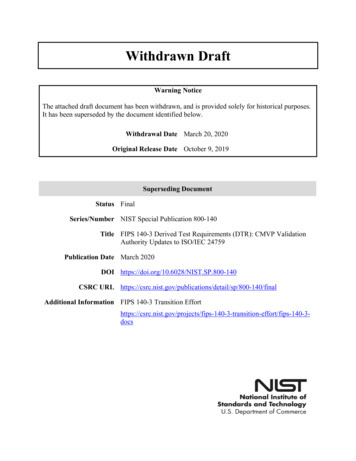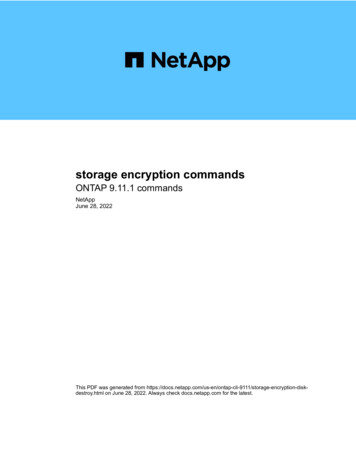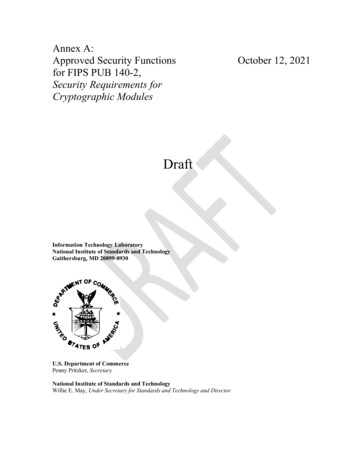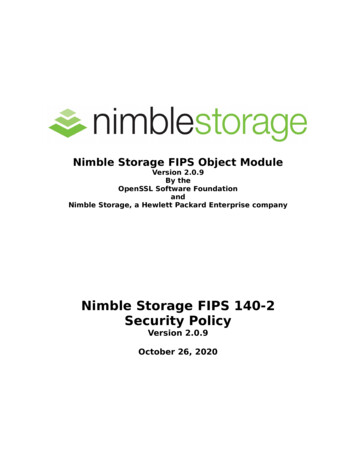
Transcription
Nimble Storage FIPS Object ModuleVersion 2.0.9By theOpenSSL Software FoundationandNimble Storage, a Hewlett Packard Enterprise companyNimble Storage FIPS 140-2Security PolicyVersion 2.0.9October 26, 2020
Nimble Storage FIPS 140 2 Security PolicyCopyright NoticeCopyright 2003 2014 the OpenSSL Software Foundation, Inc.Portions Copyright 2015 2018 Nimble StorageThis document may be freely reproduced in whole or part without permission and withoutrestriction.Sponsored by:Intersoft International, Inc.sponsor of Beaglebone Black platformsAcknowledgmentsPage 2 of 29
Nimble Storage FIPS 140 2 Security PolicyThe OpenSSL Software Foundation (OSF) serves as the "vendor" for the validation on which thisvalidation is based. Project management coordination for that effort was provided by:Steve MarquessThe OpenSSL Software Foundation1829 Mount Ephraim RoadAdamstown, MD 21710USA 1 @openssl.comwith technical work by:Stephen Henson4 Monaco Place,Westlands, Newcastle-under-LymeStaffordshire. ST5 2QT.England, United KingdomAndy PolyakovChalmers University of TechnologySE-412 96 GothenburgSwedenTim HudsonP.O. Box 6389Fairfield Gardens 4103AustraliaACN 074 537 on.comtjh@cryptsoft.comhttp://www.cryptsoft.com/in coordination with the OpenSSL Team at www.openssl.org.The original validation testing was performed by InfoGard Laboratories.validation or revalidations of software contact:Marc IrelandFIPS Program Manager, CISSPInfoGard Laboratories709 Fiero Lane, Suite 25San Luis Obispo, CA 93401For information on805-783-0810 tel805-783-0889 ge 3 of 29
Nimble Storage FIPS 140 2 Security PolicyModification History2020 10 262019 10 112018 03 092016 07 132016 05 242016 02 222015 07 072015 06 182015 04 202014 11 252014 01 042014 07 302014 07 282014 07 112014 06 122014 05 292014 05 122013 11 082013 11 012013 10 02Change references to 186 3 to 186 4. Adjust table 4a to correctly incorporate186 2 references.Remove reference to FIPS 186 2 from table 4.1a, and correct RSA certificatenumber in table 4c from #764 to #1273.Add 4 new x86 64 Operational Environments using Linux 4.4; remove referencesto Dual EC DRBG. Include “a Hewlett Packard Enterprise company” in thevendor name.Remove OpenSSL from the module name.Add 4 new x86 64 platforms: Intel E5 2603V3, E5 2620V3, E5 2680V3, and E5 2699V3.Move RNG algorithm from approved list to non approved list.Add OE entries for Linux 3.4 64 bit under Citrix XenServer without AES NI.Change last line of Table 4a from “ECC CDH (KAS)” to “ECC CDH (CVL)”.Revise platform to specify Nimble Storage platform details only (by NimbleStorage).(2.0.9) Addition of new platforms #97, #98, VMware Horizon Workspace 2.1x86 under vSphereAddition of new platform #99, QNX on ARMv4Addition of new platforms #100, #101, Apple iOS 7.1 64 bit on ARMv8Addition of new platform #96, FreeBSD 8.4 on x86 without AES NIAddition of two platforms #94, #95, FreeBSD 10.0 on x86, and re removal ofDual EC DRBGChanged processor names for platforms #90, #91Added new platforms #88, #89, ArbOS 5.3 on x86 and #92, #93 FreeBSD 9.2 onx86Temporarily remove misplaced platform, move Dual EC DRBG to the Non Approved Table 4cAdded platforms #86, #87 FreeBSD 9.1 on x86, #90 Linux ORACLESP 2.6 onASPEED AST Series (ARMv5) , #91 ORACLESP 2.6 on Emulex PILOT 3(ARMv5)Added platforms #81 Linux 2.6 on PPC, #82, #83 AcanOS 1.0 on x86, #84AcanOS 1.0 on ARMv5, #85 FreeBSD 8.4 on x86Multiple changes to separate the Approved services from those that arenon Approved per the SP 800 131A transitionAdded two platforms #79, #80 PexOS 1.0 under vSphere with/without AES NIAdded two platforms #77, #78 iOS 6.0 with/without NEONAdded six platforms (Linux 3.4 x86 virtualized under XenSource/VMware/Hyper V, with/without AES NI)Page 4 of 29
Nimble Storage FIPS 140 2 Security Policy2013 08 292013 08 142013 07 242013 06 092013 05 012013 03 012013 02 232013 02 142013 01 282013 01 082013 01 032012 12 082012 10 102011 07 022011 06 15Updated URL in Appendix A footnoteAdded new sponsor acknowledgmentAdded two Ubuntu 13.04 on ARMv7 (Beaglebone Black) and one Linux 3.8 onARMv5TEJ platformsAdded two VMware Horizon Workspace platformsFixed typo in Table 4.1a, Hash DRBGs 888 bits not 880Added QNX, iOS 6.1, eCos for revision 2.0.5Added OpenWRT 2.6 for revision 2.0.4Added VMware Horizon Mobile 1.3, Apple OS X 10.7 , Apple iOS 5.0Added WinEC7 and Android 4.0 for revision 2.0.3Table 5: Removed references to non existent Table 9Table 4a: added certsTable 4.1a: Added AES GCMAdded four platforms: Android 4.1 and Android 4.2 with and without NEONReworded section 8Added Win2008, RHEL 32/64 bit under vSphere and Win7 with AES NI.Note EC DH Key Agreement and RSA Key Wrapping strength.Added NetBSD 5.1 on PowerPC e500, NetBSD 5.1 on Intel Xeon 5500 (x86 64)for revision 2.0.2Added DSP Media Framework, Linux 2.6/Freescale PowerPC e500, Android 4.0Added iOS, WinCE 5, WinCE 6 OEsReferencesReferenceFull Specification Name[ANS X9.31]Digital Signatures Using Reversible Public Key Cryptography for the Financial ServicesIndustry (rDSA)[FIPS 140 2]Security Requirements for Cryptographic modules, May 25, 2001[FIPS 180 3]Secure Hash Standard[FIPS 186 4]Digital Signature Standard[FIPS 197]Advanced Encryption Standard[FIPS 198 1]The Keyed Hash Message Authentication Code (HMAC)[SP 800 38B]Recommendation for Block Cipher Modes of Operation: The CMAC Mode for Authentication[SP 800 38C]Recommendation for Block Cipher Modes of Operation: The CCM Mode for Authenticationand ConfidentialityPage 5 of 29
Nimble Storage FIPS 140 2 Security PolicyReferenceFull Specification Name[SP 800 38D]Recommendation for Block Cipher Modes of Operation: Galois/Counter Mode (GCM) andGMAC[SP 800 56A]Recommendation for Pair Wise Key Establishment Schemes Using Discrete LogarithmCryptography[SP 800 67R1]Recommendation for the Triple Data Encryption Algorithm (TDEA) Block Cipher[SP 800 89]Recommendation for Obtaining Assurances for Digital Signature Applications[SP 800 90]Recommendation for Random Number Generation Using Deterministic Random BitGenerators[SP 800 131A]Transitions: Recommendation for Transitioning the Use of Cryptographic Algorithms and KeyLengthsPage 6 of 29
Nimble Storage FIPS 140 2 Security PolicyTable of Contents1 Introduction.72 Tested Configurations.93 Ports and Interfaces .134 Modes of Operation and Cryptographic Functionality .144.1 Critical Security Parameters and Public Keys.185 Roles, Authentication and Services .216 Self test.237 Operational Environment.258 Mitigation of other Attacks.26Appendix A Installation and Usage Guidance.27Appendix B Controlled Distribution File Fingerprint.30Appendix C Compilers.33Page 7 of 29
Nimble Storage FIPS 140 2 Security Policy1IntroductionThis document is the non proprietary security policy for the Nimble Storage FIPS ObjectModule, hereafter referred to as the Module, which is build from the OpenSSL FIPS ObjectModule source code according to the the instructions in Appendix A.The Module is a software library providing a C language application program interface (API) foruse by other processes that require cryptographic functionality. The Module is classified by FIPS140 2 as a software module, multi chip standalone module embodiment. The physicalcryptographic boundary is the general purpose computer on which the module is installed. Thelogical cryptographic boundary of the Module is the fipscanister object module, a single objectmodule file named fipscanister.o compiled on Linux 1 . The Module performs nocommunications other than with the calling application (the process that invokes the Moduleservices).The FIPS 140 2 security levels for the Module are as follows:Security RequirementSecurity LevelCryptographic Module Specification1Cryptographic Module Ports and Interfaces1Roles, Services, and Authentication2Finite State Model1Physical SecurityNAOperational Environment1Cryptographic Key Management1EMI/EMC1Self Tests1Design Assurance3Mitigation of Other AttacksNATable 1 – Security Level of Security RequirementsThe Module’s software version for this validation is 2.0.9. It is build from the 2.0.9 version ofthe OpenSSL FIPS Object Module source code.1 Linux is the registered trademark of Linus Torvalds in the U.S. and other countries.Page 8 of 29
Nimble Storage FIPS 140 2 Security PolicyFigure 1 Module Block DiagramPage 9 of 29
Nimble Storage FIPS 140 2 Security Policy2Tested Configurations#Operational EnvironmentProcessorOptimiz ations(Target)ECB1Linux 2.6Intel E5 2403V2 (x86 64)AES NIBKPU22Linux 2.6Intel E5 2450V2 (x86 64)AES NIBKPU23Linux 2.6Intel E5 2470V2 (x86 64)AES NIBKPU24Linux 3.4 64 bit under Citrix XenServerIntel Xeon E5 2430L (x86)NoneBKPU25Linux 2.6Intel E5 2603V3 (x86 64)AES NIBKPU26Linux 2.6Intel E5 2620V3 (x86 64)AES NIBKPU27Linux 2.6Intel E5 2680V3 (x86 64)AES NIBKPU28Linux 2.6Intel E5 2699V3 (x86 64)AES NIBKPU29Linux 4.4Intel E5504 (x86 64)NoneBKPU210Linux 4.4Intel E5 2403V2 (x86 64)AES NIBKPU211Linux 4.4Intel E5 2680V3 (x86 64)AES NIBKPU212Linux 4.4Intel Xeon Silver 4110 (x86 64)AES NIBKPU2Table 2 Tested Configurations (B Build Method; EC Elliptic Curve Support). The EC column indicatessupport for prime curve only (P), or all NIST defined B, K, and P curves (BKP).See Appendix A for additional information on build method and optimizations. See Appendix Cfor a list of the specific compilers used to generate the Module for the respective operationalenvironments.Page 10 of 29
Nimble Storage FIPS 140 2 Security Policy3Ports and InterfacesThe physical ports of the Module are the same as the computer system on which it is executing.The logical interface is a C language application program interface (API).Logical interface typeDescriptionControl inputAPI entry point and corresponding stack parametersData inputAPI entry point data input stack parametersStatus outputAPI entry point return values and status stack parametersData outputAPI entry point data output stack parametersTable 3 Logical interfacesAs a software module, control of the physical ports is outside module scope. However, when themodule is performing self tests, or is in an error state, all output on the logical data outputinterface is inhibited. The module is single threaded and in error scenarios returns only an errorvalue (no data output is returned).Page 11 of 29
Nimble Storage FIPS 140 2 Security Policy4Modes of Operation and Cryptographic FunctionalityThe Module supports only a FIPS 140 2 Approved mode. Tables 4a and 4b list the Approvedand Non approved but Allowed algorithms, respectively.FunctionRandom NumberGeneration;Symmetric keygenerationEncryption,Decryption andCMACMessage DigestsKeyed HashDigital Signature andAsymmetric KeyGenerationAlgorithmOptionsCert #[SP 800 90A] DRBG2Prediction resistancesupported for all variationsHash DRBGHMAC DRBG, no reseedCTR DRBG (AES), no derivation function342,784[SP 800 67]3 Key Triple DES TECB, TCBC, TCFB,TOFB; CMAC generate and verify128/ 192/256 ECB, CBC, OFB, CFB 1, CFB 8,CFB 128, CTR, XTS; CCM; GCM; CMACgenerate and verify1522,19122484,3351SHA 1, SHA 2 (224, 256, 384, 512)2102,2778[FIPS 198] HMACSHA 1, SHA 2 (224, 256, 384, 512)[FIPS 186 2] RSASigVer9.31 (1024/1536/2048/3072/4096 withSHA 1/256/384/512)SigVerPKCS1.5, SigVerPSS(1024/1536/2048/3072/4096 with all SHA 1/SHA2 sizes)SigGen9.31 (2048/3072/4096 with SHA 256/384/512)SigGenPKCS1.5, SigGenPSS (2048/3072/4096with all SHA2 sizes)PQG Gen, PQG Ver, Key Pair Gen, Sig Gen,Sig Ver (1024/2048/3072 with all SHA 2 sizes)1526,21341273,1718[FIPS 197] AES[SP 800 38B] CMAC[SP 800 38C] CCM[SP 800 38D] GCM[SP 800 38E] XTS[FIPS 180 3][FIPS 186 4] RSA[FIPS 186 4] DSA1718764,9502 For all DRBGs the "supported security strengths" is just the highest supported security strength per [SP800 90]and [SP800 57].Page 12 of 29
Nimble Storage FIPS 140 2 Security Policy[FIPS 186 4] ECDSAECC CDH (CVL)[SP 800 56A] (§5.7.1.2)PKG: CURVES( P 224 P 256 P 384 P 521 K 224 K 256 K 384 K 521 B 224 B 256 B 384 B 521 ExtraRandomBits TestingCandidates )PKV: CURVES( ALL P ALL K ALL B )SigGen: CURVES( P 224: (SHA 224, 256, 384,512) P 256: (SHA 224, 256, 384, 512) P 384:(SHA 224, 256, 384, 512) P 521: (SHA 224,256, 384, 512) K 233: (SHA 224, 256, 384,512) K 283: (SHA 224, 256, 384, 512) K 409:(SHA 224, 256, 384, 512) K 571: (SHA 224,256, 384, 512) B 233: (SHA 224, 256, 384, 512)B 283: (SHA 224, 256, 384, 512) B 409: (SHA 224, 256, 384, 512) B 571: (SHA 224, 256, 384,512) )SigVer: CURVES( P 192: (SHA 1, 224, 256,384, 512) P 224: (SHA 1, 224, 256, 384, 512) P 256: (SHA 1, 224, 256, 384, 512) P 384: (SHA 1, 224, 256, 384, 512) P 521: (SHA 1, 224, 256,384, 512) K 163: (SHA 1, 224, 256, 384, 512)K 233: (SHA 1, 224, 256, 384, 512) K 283:(SHA 1, 224, 256, 384, 512) K 409: (SHA 1,224, 256, 384, 512) K 571: (SHA 1, 224, 256,384, 512 B 163: (SHA 1, 224, 256, 384, 512) B 233: (SHA 1, 224, 256, 384, 512) B 283: (SHA 1, 224, 256, 384, 512) B 409: (SHA 1, 224, 256,384, 512) B 571: (SHA 1, 224, 256, 384, 512) )All NIST defined B, K and P curves except sizes163 and 192413,66485,496Table 4a – FIPS Approved Cryptographic FunctionsThe Module supports only NIST defined curves for use with ECDSA and ECC CDH. TheModule supports two operational environment configurations for elliptic curve; NIST primecurve only (listed in Table 2 with the EC column marked "P") and all NIST defined curves(listed in Table 2 with the EC column marked "BKP").CategoryAlgorithmKey AgreementEC DHKey Encryption,DecryptionRSADescriptionNon compliant (untested) DH scheme using elliptic curve, supporting allNIST defined B, K and P curves. Key agreement is a service providedfor calling process use, but is not used to establish keys into the Module.The RSA algorithm may be used by the calling application forencryption or decryption of keys. No claim is made for SP 800 56Bcompliance, and no CSPs are established into or exported out of themodule using these services.Table 4b – Non FIPS Approved But Allowed Cryptographic FunctionsPage 13 of 29
Nimble Storage FIPS 140 2 Security PolicyFunctionRandom NumberGeneration;Symmetric keygenerationDigital Signature andAsymmetric KeyGenerationECC CDH (CVL)Algorithm[ANS X9.31] RNGOptionsCert#AES 128/192/2561202,1363GenKey9.31, SigGen9.31, SigGenPKCS1.5,SigGenPSS (1024/1536 with all SHA sizes,2048/3072/4096 with SHA 1)[FIPS 186 2] DSAPQG Gen, Key Pair Gen, Sig Gen (1024 with allSHA sizes, 2048/3072 with SHA 1)[FIPS 186 4] DSAPQG Gen, Key Pair Gen, Sig Gen (1024 with allSHA sizes, 2048/3072 with SHA 1)[FIPS 186 2] ECDSAPKG: CURVES( P 192 K 163 B 163 )SIG(gen): CURVES( P 192 P 224 P 256 P 384P 521 K 163 K 233 K 283 K 409 K 571 B 163B 233 B 283 B 409 B 571 )[FIPS 186 4] ECDSAPKG: CURVES( P 192 K 163 B 163 )SigGen: CURVES( P 192: (SHA 1, 224, 256,384, 512) P 224:(SHA 1) P 256:(SHA 1) P 384:(SHA 1) P 521:(SHA 1) K 163: (SHA 1, 224,256, 384, 512) K 233:(SHA 1) K 283:(SHA 1)K 409:(SHA 1) K 571:(SHA 1) B 163: (SHA 1,224, 256, 384, 512) B 233:(SHA 1) B 283:(SHA 1) B 409:(SHA 1) B 571:(SHA 1) )[SP 800 56A] (§5.7.1.2)All NIST Recommended B, K and P curvessizes 163 and 192Table 4c – FIPS Non Approved Cryptographic Functions1273[FIPS 186 2] RSA76476441341385These algorithms shall not be used when operating in the FIPS Approved mode of operation.EC DH Key Agreement provides a maximum of 256 bits of security strength. RSA KeyWrapping provides a maximum of 256 bits of security strength.The Module requires an initialization sequence (see IG 9.5): the calling application invokesFIPS mode set()3, which returns a “1” for success and “0” for failure. If FIPS mode set()fails then all cryptographic services fail from then on. The application can test to see if FIPSmode has been successfully performed.The Module is a cryptographic engine library, which can be used only in conjunction withadditional software. Aside from the use of the NIST defined elliptic curves as trusted third partydomain parameters, all other FIPS 186 4 assurances are outside the scope of the Module, and arethe responsibility of the calling process.3 The function call in the Module is FIPS module mode set() which is typically used by an application via theFIPS mode set() wrapper function.Page 14 of 29
Nimble Storage FIPS 140 2 Security Policy4.1Critical Security Parameters and Public KeysAll CSPs used by the Module are described in this section. All access to these CSPs by Moduleservices are described in Section 4. The CSP names are generic, corresponding to API parameterdata structures.CSP NameDescriptionRSA SGKRSA (1024 to 16384 bits) signature generation keyRSA KDKRSA (1024 to 16384 bits) key decryption (private key transport) keyDSA SGK[FIPS 186 4] DSA (1024/2048/3072) signature generation keyECDSA SGKECDSA (All NIST defined B, K, and P curves) signature generation keyEC DH PrivateEC DH (All NIST defined B, K, and P curves) private key agreement key.AES EDKAES (128/192/256) encrypt / decrypt keyAES CMACAES (128/192/256) CMAC generate / verify keyAES GCMAES (128/192/256) encrypt / decrypt / generate / verify keyAES XTSAES (256/512) XTS encrypt / decrypt keyTriple DES EDKTriple DES (3 Key) encrypt / decrypt keyTriple DES CMACTriple DES (3 Key) CMAC generate / verify keyHMAC KeyKeyed hash key (160/224/256/384/512)Hash DRBG CSPsCO AD DigestV (440/888 bits) and C (440/888 bits), entropy input (length dependent on securitystrength)V (160/224/256/384/512 bits) and Key (160/224/256/384/512 bits), entropy input(length dependent on security strength)V (128 bits) and Key (AES 128/192/256), entropy input (length dependent on securitystrength)Pre calculated HMAC SHA 1 digest used for Crypto Officer role authenticationUser AD DigestPre calculated HMAC SHA 1 digest used for User role authenticationHMAC DRBG CSPsCTR DRBG CSPsTable 4.1a – Critical Security ParametersAuthentication data is loaded into the module during the module build process, performed by anauthorized operator (Crypto Officer), and otherwise cannot be accessed.The module does not output intermediate key generation values.CSP NameDescriptionRSA SVKRSA (1024 to 16384 bits) signature verification public keyRSA KEKRSA (1024 to 16384 bits) key encryption (public key transport) keyDSA SVKECDSA SVK[FIPS 186 4] DSA (1024/2048/3072) signature verification key or [FIPS 186 2] DSA(1024) signature verification keyECDSA (All NIST defined B, K and P curves) signature verification keyEC DH PublicEC DH (All NIST defined B, K and P curves) public key agreement key.Page 15 of 29
Nimble Storage FIPS 140 2 Security PolicyTable 4.1b – Public KeysFor all CSPs and Public Keys:Storage: RAM, associated to entities by memory location. The Module stores DRBG statevalues for the lifetime of the DRBG instance. The module uses CSPs passed in by the callingapplication on the stack. The Module does not store any CSP persistently (beyond thelifetime of an API call), with the exception of DRBG state values used for the Modules'default key generation service.Generation: The Module implements SP 800 90 compliant DRBG services for creation ofsymmetric keys, and for generation of DSA, elliptic curve, and RSA keys as shown in Table4a. The calling application is responsible for storage of generated keys returned by themodule.Entry: All CSPs enter the Module’s logical boundary in plaintext as API parameters,associated by memory location. However, none cross the physical boundary.Output: The Module does not output CSPs, other than as explicit results of key generationservices. However, none cross the physical boundary.Destruction: Zeroization of sensitive data is performed automatically by API function callsfor temporarily stored CSPs. In addition, the module provides functions to explicitly destroyCSPs related to random number generation services. The calling application is responsiblefor parameters passed in and out of the module.Private and secret keys as well as seeds and entropy input are provided to the Module by thecalling application, and are destroyed when released by the appropriate API function calls. Keysresiding in internally allocated data structures (during the lifetime of an API call) can only beaccessed using the Module defined API. The operating system protects memory and processspace from unauthorized access. Only the calling application that creates or imports keys canuse or export such keys. All API functions are executed by the invoking calling application in anon overlapping sequence such that no two API functions will execute concurrently. Anauthorized application as user (Crypto Officer and User) has access to all key data generatedduring the operation of the Module.In the event Module power is lost and restored the calling application must ensure that anyAES GCM keys used for encryption or decryption are re distributed.Module users (the calling applications) shall use entropy sources that meet the security strengthrequired for the random number generation mechanism: 128 bits as shown in [SP 800 90] Table2 (Hash DRBG, HMAC DRBG), and Table 3 (CTR DRBG). This entropy is supplied bymeans of callback functions. Those functions must return an error if the minimum entropystrength cannot be met.Page 16 of 29
Nimble Storage FIPS 140 2 Security Policy5Roles, Authentication and ServicesThe Module implements the required User and Crypto Officer roles and requires authenticationfor those roles. Only one role may be active at a time and the Module does not allow concurrentoperators. The User or Crypto Officer role is assumed by passing the appropriate password tothe FIPS module mode set() function. The password values may be specified at build timeand must have a minimum length of 16 characters. Any attempt to authenticate with an invalidpassword will result in an immediate and permanent failure condition rendering the Moduleunable to enter the FIPS mode of operation, even with subsequent use of a correct password.Authentication data is loaded into the Module during the Module build process, performed by theCrypto Officer, and otherwise cannot be accessed.Since minimum password length is 16 characters, the probability of a random successfulauthentication attempt in one try is a maximum of 1/25616, or less than 1/1038. The Modulepermanently disables further authentication attempts after a single failure, so this probability isindependent of time.Both roles have access to all of the services provided by the Module. User Role (User): Loading the Module and calling any of the API functions.Crypto Officer Role (CO): Installation of the Module on the host computer system andcalling of any API functions.All services implemented by the Module are listed below, along with a description of serviceCSP access.ServiceRoleDescriptionInitializeUser, COModule initialization. Does not access CSPs.Self testUser, COPerform self tests (FIPS selftest). Does not access CSPs.User, COFunctions that provide module status information: Version (as unsigned long or const char *) FIPS Mode (Boolean)Does not access CSPs.ZeroizeUser, COFunctions that destroy CSPs: fips drbg uninstantiate: for a given DRBG context, overwrites DRBG CSPs(Hash DRBG CSPs, HMAC DRBG CSPs, CTR DRBG CSPs)All other services automatically overwrite CSPs stored in allocated memory. Stackcleanup is the responsibility of the calling application.RandomnumbergenerationUser, COShow statusUsed for random number and symmetric key generation. Seed or reseed an DRBG instance Determine security strength of a DRBG instancePage 17 of 29
Nimble Storage FIPS 140 2 Security PolicyServiceRoleDescription Obtain random dataUses and updates Hash DRBG CSPs, HMAC DRBG CSPs, CTR DRBG CSPs.Asymmetrickey generationUser, COUsed to generate DSA, ECDSA and RSA keys:RSA SGK, RSA SVK; DSA SGK, DSA SVK; ECDSA SGK, ECDSA SVKThere is one supported entropy strength for each mechanism and algorithm type, themaximum specified in SP800 90SymmetricUser, COencrypt/decryptUsed to encrypt or decrypt data.Executes using AES EDK, Triple DES EDK (passed in by the calling process).SymmetricdigestUsed to generate or verify data integrity with CMAC.Executes using AES CMAC, Triple DES, CMAC (passed in by the calling process).User, COMessage digest User, COUsed to generate a SHA 1 or SHA 2 message digest.Does not access CSPs.Keyed HashUser, COUsed to generate or verify data integrity with HMAC.Executes using HMAC Key (passed in by the calling process).Key transport4User, COUsed to encrypt or decrypt a key value on behalf of the calling process (does notestablish keys into the module).Executes using RSA KDK, RSA KEK (passed in by the calling process).Key agreementUser, COUsed to perform key agreement primitives on behalf of the calling process (does notestablish keys into the module).Executes using EC DH Private, EC DH Public (passed in by the calling process).DigitalsignatureUser, COUsed to generate or verify RSA, DSA or ECDSA digital signatures.Executes using RSA SGK, RSA SVK; DSA SGK, DSA SVK; ECDSA SGK,ECDSA SVK (passed in by the calling process).UtilityUser, COMiscellaneous helper functions. Does not access CSPs.Table 5 Services and CSP Access6Self testThe Module performs the self tests listed below on invocation of Initialize or Self test.AlgorithmTypeTest AttributesSoftware integrityKAT HMAC SHA1HMACKAT One KAT per SHA1, SHA224, SHA256, SHA384 and SHA512Per IG 9.3, this testing covers SHA POST requirements.AESKAT Separate encrypt and decrypt, ECB mode, 128 bit key lengthAES CCMKAT Separate encrypt and decrypt, 192 key length4 "Key transport" can refer to a) moving keys in and out of the module or b) the use of keys by an externalapplication. The latter definition is the one that applies to the Nimble Storage FIPS Object Module.Page 18 of 29
Nimble Storage FIPS 140 2 Security PolicyAlgorithmTypeTest AttributesAES GCMKAT Separate encrypt and decrypt, 256 key lengthXTS AESKAT 128, 256 bit key sizes to support either the 256 bit key size (for XTS AES 128) orthe 512 bit key size (for XTS AES 256)AES CMACKAT Sign and verify CBC mode, 128, 192, 256 key lengthsTriple DESKAT Separate encrypt and decrypt, ECB mode, 3 KeyTriple DES CMACKAT CMAC generate and verify, CBC mode, 3 KeyRSAKAT Sign and verify using 2048 bit key, SHA 256, PKCS#1DSAPCT Sign and verify using 2048 bit key, SHA 384DRBGKAT CTR DRBG: AES, 256 bit with and without derivation functionHASH DRBG: SHA256HMAC DRBG: SHA256ECDSAPCT Keygen, sign, verify using P 224, K 233 and SHA512. The K 233 self test is notperformed for operational environments that support prime curve only (see Table2).ECC CDHKAT Shared secret calculation per SP 800 56A §5.7.1.2, IG 9.6Table 6a Power On Self Tests (KAT Known answer test; PCT Pairwise consistency test)The Module is installed using one of the set of instructions in Appendix A, as appropriate for thetarget system. The HMAC SHA 1 of the Module distribution file as tested by the CMTLaboratory and listed in Appendix A is verified during installation of the Module file asdescribed in Appendix A.The FIPS mode set()5 function performs all power up self tests listed above with no operatorintervention required, returning a “1” if all power up self tests succeed, and a “0” otherwise. Ifany component of the power up self test fails an internal flag is set to prevent subsequentinvocation of any cryptographic function calls. The module will only enter the FIPS Approvedmode if the module is reloaded and the call to FIPS mode set()5 succeeds.The power up self tests may also be performed on demand by calling FIPS selftest(), whichreturns a “1” for success and “0” for failure. Interpretation of this return code is the responsibilityof the calling application.The Module also implements the following conditional tests:Algorithm5TestDRBGTested as required by [SP800 90] Section 11DRBGFIPS 140 2 continuous test for stuck faultDSAPairwise consistency test on each generation of a key pairECDSAPairwise consistency test on each generation of a key pairFIPS mode set()calls Module function FIPS module mode set()Page 19 of 29
Nimble Storage FIPS 140 2 Security PolicyAlgorithmRSATestPairwise consistency test on each generation of a key pairTable 6b Conditional TestsIn the event of a DRBG self test failure the calling application must uninstantiate and re instantiate the DRBG per the requirements of [SP 800 90]; this is not something the Module cando itself.Pairwise consistency tests are performed for both possible modes of use, e.g. Sign/Verify andEncrypt/Decrypt.The Module supports two operational environment configurations for elliptic curve: NIST primecurves only (listed in Table 2 with the EC column marked "P") and all NIST defined curves(listed in Table 2 with the EC column marked "BKP").Page 20 of 29
Nimble Storage FIPS 140 2
Nimble Storage FIPS 140 2 Security Policy 1 Introduction This document is the non proprietary security policy for the Nimble Storage FIPS Object Module, hereafter referred to as the Module, which is build from the OpenSSL FIPS Object Module source code according to the the instructions in Appendix A.
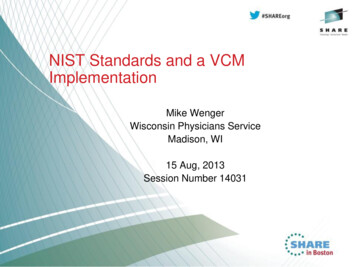
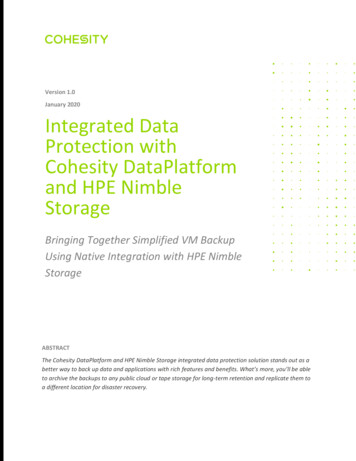
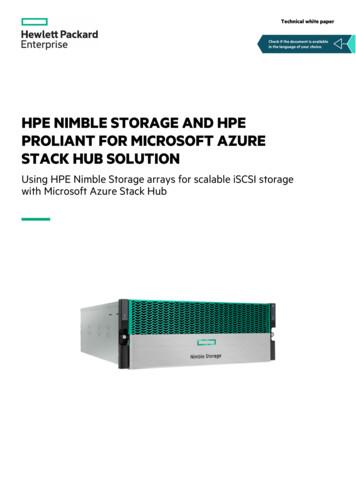
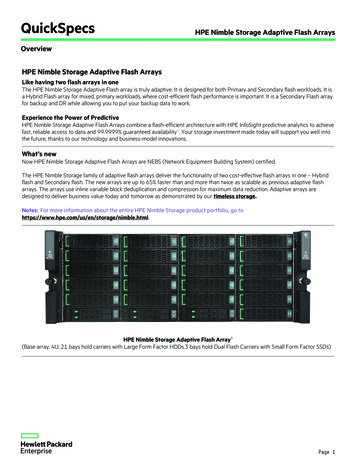
![Welcome [meec-edu ]](/img/34/system-source-nimble-storage-meec-webinar1.jpg)


